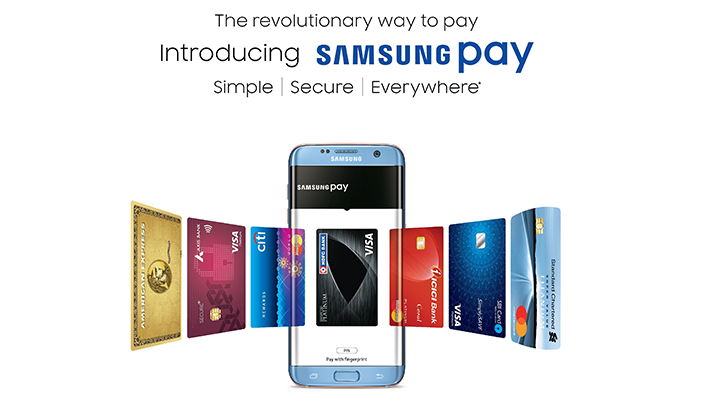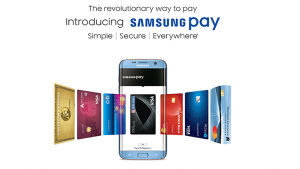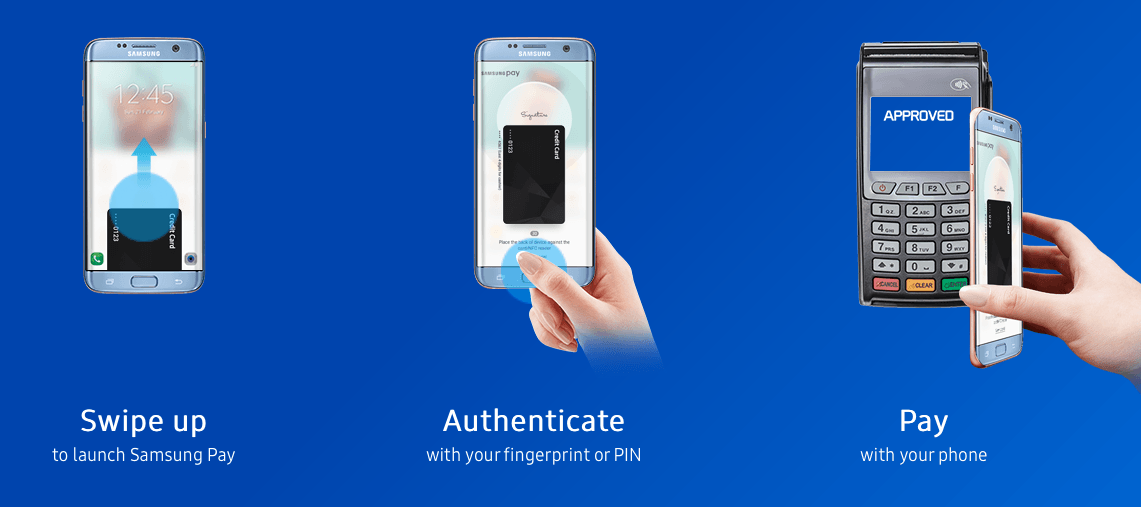
April 23, 2017 / Kannan / 0 Comments
Samsung Pay is now available in India and I am delighted !

Pre March 2017…..
In India transactions at shops happen in three ways generally.
- Pay in cash
- Swipe your debit or credit card and pay
- Use digital wallets like Paytm
Issues one might face with cash is, unavailability of proper change or too much of cash in the wallet leading to larger wallets getting either pick pocketed or when most of the people keep it in their back pockets it has impact on your spinal cord.
With debit or credit cards, the magnetic strip wears off after repeated usage or lost. Replacement of cards are generally charged.
Using digital wallets requires an amount to be stored in their account and some times it’s an issue when some out lets don’t support them.
I pay mostly using digital mode until unless the total bill is less than ₹100.00
Following were some of the the issue which I faced.
- Wear and tear of debit card or the machine
- I leave my wallet at home
- QR code at shop is worn off and my banking app doesn’t recognize it
Especially after demonetization resulting in crash crunch, people started to use digital mode of payment more frequently which resulted in POS machines wearing off more frequently.
Post March 2017…..
Samsung launches Samsung Pay in India with almost all the Indian banks being supported.
Initially I was little hesitant, but then decided to try for one particular reason of it being supporting the magnetic readers based machine too as opposed to NFC only. Following is what I did,
- Update the Samsung Pay to latest
- Register my debit card and agreed for virtual card to be created
- Confirm addition of card via OTP
Now my mobile has a digital card added to it’s lock, home screen.
I went out for a purchase and when I was supposed to pay the bill the shop keeper requested me to handover the debit or credit card. I told him I will pay via mobile and he was little confused.
- So I got the POS Swipe machine from him
- Pressed the power button in my mobile to show the lock screen
- Swipe up the Samsung Pay app
- Choose the debit card
- Keep the mobile near the magnetic reader of the swipe machine
- Then payment was same as swiping the card
- Enter amount
- Enter pin
- Payment approved slip being printed out

It was very easy.
Following are some of the advantages of Samsung Pay
- It supports both NFC based and magnetic based readers, hence more POS machines are supported
- Samsung’s KNOX (a secure storage space inside mobile) stores the information about the virtual card
- I guess Apple supports only NFC and hence less number of POS machines supported
- Also Apple and native Android has lower number of banking support in India
The interesting part is people around you are shocked to see such a payment system is available in India !
Copyright note: Image in the article belong to various other websites and copyright resides with them.
October 6, 2014 / Kannan / 0 Comments

Cloning of Virtual Machine using Hyper-V is not a one step process, but still nevertheless it’s easy as the following numbered list. But why this is required is something which is not explained in all the sites.
- Create a VM with intended Windows in Hyper-V
- Update the Windows VM
- Sysprep the Windows VM
Fortunately, I found an article series which explains the process as well as what goes behind the scenes. Even though the articles is targeted towards Windows Server 2003 and 2008, I found the article to be 100% relevant for Windows Server 2012 R2 as well.
The article is a 4 part article which you can check below.
Cloning Hyper-V Virtual Machines the Right Way (Part 1)
Cloning Hyper-V Virtual Machines the Right Way (Part 2)
Cloning Hyper-V Virtual Machines the Right Way (Part 3)
Cloning Hyper-V Virtual Machines the Right Way (Part 4)
Thanks to Brien M. Posey for writing this article.Thanks
March 25, 2014 / Kannan / 0 Comments

SharePoint & Windows
A post describing SharePoint’s high resource usage and how Windows 8’s Boot to VHD will help to run SharePoint host with more dedicated resource.
Trailer….
For people like me who has to depend on resource hungry SharePoint servers, life is difficult as a developer and IT designer.
Most of the time we have to run the server inside a virtual environment and most of the time it would be a standalone server.
The problem….
Initially with SharePoint 2010 you could get away with at-least 6GB RAM allocated to a guest OS. But with SharePoint 2013 you require at least 12GB for a better experience and most of the machines come with 8GB or 16 GB RAM.
The problem is, your host OS will take at least 2GB RAM which for SharePoint can make life and death kind of experience even though Windows is perfectly capable of keeping SharePoint alive with paging (Virtual RAM) and have the storage drive on a never ending marathon run !
For virtual environment, the following are the options we generally have.
- Microsoft Virtual PC (Free)
- VMWare Workstation (Costly)
- Oracle Virtualbox (Free)
- Windows Server 2008/2012 R2’s Hyper-V (Super Costly)
Out of these, VirtualPC and Hyper-V natively use VHD container format for guest OS. Others too have these (Thanks to Microsoft’s Open Specification Promise) but mostly they use proprietary format.
When Windows 7 was rolled out, the Enterprise & Ultimate editions had the native Boot-to-VHD support.
What is Boot To VHD ?
Refers to the ability of a physical computer to mount and boot from an operating system contained within a VHD – (PS: Shamelessly copied the text from wikipedia)
Again to the problem….
Consider a scenario where you own a VM host system with 8GB RAM and run a VM guest with 6GB RAM for SharePoint 2010. This worked mostly fine. Then comes the SharePoint 2013 which requires even more ram, at-least 2GB in addition. Now you are in soup, you can wait forever to see the guest OS, aka Windows Server 2008 R2 or Windows Server 2012’s desktop to show up!
Solution….
Gain as much RAM as possible from host or upgrade the system to have more RAM. You will be in luck for desktop systems. Laptops, you are mostly in trouble.
Windows 7…..
Luckily with Windows 7(Enterprise/Ultimate) you could boot physical computer to a VHD and utilize all the resources. That’s good news, now you have all the RAM available for the SharePoint. The bad news is Enterprise is available for volume licensing only and Ultimate prohibitively costly.
Windows 8…..(forget Windows 8 RT, that thing can’t even run a standalone app!, but still a good OS for daily basic usage, so Microsoft is forgiven!)
Then comes Windows 8 with even more simpler editions. A regular version, professional version & an enterprise version. Compared to Windows 7, Windows 8 Pro is affordable and can be bought by an individual.
The best news is, Windows 8 Pro comes with Client Hyper-V and supports Boot To VHD.
So now as an indie SharePoint developer, you have a host OS which can be bought, has a virtualization capability and supports Boot To VHD.
Assuming you bought the host OS, i.e. Windows 8 Pro, its time to utilize it for better SharePoint development experience.
PS: I am going to explain only Boot-to-VHD part. Enabling Hyper-V in Window 8 Pro or installing SharePoint are out of scope for this post. Get help from trusted friend Google’s Search or Microsoft’s Bing.
After a long story…Main Picture…..
Enabling boot-to-VHD…..
- Create a VM Guest using Hyper-V and make a note of the location where the VHD file is located.
- In VM Host, go to Control Panel, Administrative Tools, Computer Management. Go to Disk Management under Storage.




- In Action menu, click Attach VHD. Now you should have a volume with drive letter. Make a note of the drive letter. In this case it’s D:\



- Now launch a command prompt as administrator.
- Take a backup of current boot information by using the following command
bcdedit /export C:\bcdcurrentbackup

- Now let’s add the VHD’s Windows to boot by using the following command (The drive letter we noted will be used here)
bcdboot D:\Windows

- Reboot the machine and you should be able to see the multi boot screen.

- Choose the SharePoint’s guest OS to boot.
You can use bcdedit command to rename the description of the Windows in multi boot screen.
Removing boot-to-VHD…
- Open command prompt in admin mode
- As mentioned in point 5 above take a backup of the boot system file
- View list of current boot entries by typing the following
bcdedit



- Make a note of the guid in the entries. In this case it’s {4ff0aa40-b17f-11e3-beaa-bc5ff4cf029e}
- Delete the entry by typing the following command
bcdedit /delete {4ff0aa40-b17f-11e3-beaa-bc5ff4cf029e} 

January 28, 2013 / Kannan / 0 Comments
US Defence might soon or already have a 1.8 gigapixel video surveillance system called “ARGUS-IS” which should be able to identify a 6″ item from an altitude of 17,000 feet !
Take a look at the amazing technology in the below video !
[embedplusvideo height=”281″ width=”450″ standard=”http://www.youtube.com/v/QGxNyaXfJsA?fs=1″ vars=”ytid=QGxNyaXfJsA&width=450&height=281&start=&stop=&rs=w&hd=0&autoplay=0&react=0&chapters=¬es=” id=”ep6262″ /]
Source: Reddit
January 7, 2012 / Kannan / 0 Comments
Another EV which will not see the day light, but looks good.
This EV is supposed to give 100-mile range and a top speed of 65 miles per hour.
Some Pictures












Source: Auto Blog
August 25, 2011 / Kannan / 0 Comments
The following MS SQL query can be used to get list of tables along with their column details.
SELECT * FROM INFORMATION_SCHEMA.COLUMNS
Source : MSDN Forum
July 27, 2011 / Kannan / 0 Comments
Standard for Wireless Regional Area Networks in TV Whitespaces – What it basically means is a long range wireless broadband access.
More about the press release below…
PISCATAWAY, N.J.–(BUSINESS WIRE)–IEEE, the world’s largest professional association advancing technology for humanity, today announced that it has published the IEEE 802.22TM standard. IEEE 802.22 systems will provide broadband access to wide regional areas around the world and bring reliable and secure high-speed communications to under-served and un-served communities.
This new standard for Wireless Regional Area Networks (WRANs) takes advantage of the favorable transmission characteristics of the VHF and UHF TV bands to provide broadband wireless access over a large area up to 100 km from the transmitter. Each WRAN will deliver up to 22 Mbps per channel without interfering with reception of existing TV broadcast stations, using the so-called white spaces between the occupied TV channels. This technology is especially useful for serving less densely populated areas, such as rural areas, and developing countries where most vacant TV channels can be found.
IEEE 802.22 incorporates advanced cognitive radio capabilities including dynamic spectrum access, incumbent database access, accurate geolocation techniques, spectrum sensing, regulatory domain dependent policies, spectrum etiquette, and coexistence for optimal use of the available spectrum.
The IEEE 802.22 Working Group started its work following the Notice of Inquiry issued by the United States Federal Communications Commission on unlicensed operation in the TV broadcast bands.
Additional information on the standard can be found at the IEEE 802.22 WG page. To purchase the standard, visit the IEEE Standards Store.
To learn more about IEEE-SA, visit us on Facebook at http://www.facebook.com/ieeesa, follow us on Twitter at http://www.twitter.com/ieeesa or connect with us on the Standards Insight Blog at http://www.standardsinsight.com.
Source: http://www.businesswire.com/news/home/20110726007223/en/IEEE-802.22TM-2011-Standard-Wireless-Regional-Area-Networks
April 16, 2011 / Kannan / 0 Comments
An heading which says “Solar power without solar cells: A hidden magnetic effect of light could make it possible”. A discovery has been made at University of Michigan, the magnetic effect which previously was ignored due to weak magnetic field can now be made strong 100 millions times. This could lead to a new kind of solar cell without semiconductors and without absorption to produce charge separation.
The following are some of the excerpts.
Light has electric and magnetic components. Until now, scientists thought the
effects of the magnetic field were so weak that they could be ignored. What Rand
and his colleagues found is that at the right intensity, when light is traveling
through a material that does not conduct electricity, the light field can
generate magnetic effects that are 100 million times stronger than previously
expected. Under these circumstances, the magnetic effects develop strength
equivalent to a strong electric effect.
“This could lead to a new kind of solar cell without
semiconductors and without absorption to produce charge separation,” Rand said.
“In solar cells, the light goes into a material, gets absorbed and creates heat.
Here, we expect to have a very low heat load. Instead of the light being
absorbed, energy is stored in the magnetic moment. Intense magnetization can be
induced by intense light and then it is ultimately capable of providing a
capacitive power source.”
Read more at http://ns.umich.edu/htdocs/releases/story.php?id=8368
































